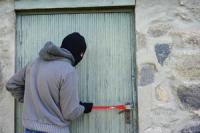-
How China could shut down America’s defenses
Advanced U.S. weapons are almost entirely reliant on rare-earth materials only made in China—and they could be a casualty of the trade war. Keith Johnson and Lara Seligman write in Foreign Policy that President Donald Trump has often argued that China has much more to lose than the United States in a trade war, but critics say his administration has failed to address a major U.S. vulnerability: Beijing maintains powerful leverage over the war-making capability of its main strategic rival through its control of critical materials.
-
-
Dystopian Future Watch: Is San Francisco’s facial recognition ban too little, too late?
Life just keeps creeping along, leading us step-by-step closer to living in a Philip K. Dick dystopian future—in real-time. And often, in our surveillance culture, we are willing participants to work alongside Big Brother. Harmon Leon writes in the Observer that Remember how fun it used to be to see facial recognition and retina scanning in sci-fi movies? We loved it in RoboCop and Blade Runner, right? Now, many of these biometrictechnologies have become a nightmarish reality.
-
-
Virginia Beach shooting reflects trend toward more powerful handguns
Like most mass shooters, the Virginia Beach gunman used a handgun. And like a growing number of American gun-buyers, he had a preference for some of the most powerful weapons available on the market. The use of semiautomatic handguns since 1990 has outpaced an already growing gun market.
-
-
Showing emergency responders the fastest, safest path to incident scenes
Getting to your destination has never been easier, thanks to a number of popular global positioning systems (GPS) -based navigation apps available for download on smart devices. For first responders, there can be drawbacks to using the same apps and following the same routes as everyone else. When every second counts getting to an emergency scene, good enough just won’t cut it.
-
-
Finding fake fingerprints
From a security perspective, what’s to stop a third party “lifting” your fingerprint, and creating a facsimile of its loops, whorls and arches with a piece of a skin-like rubbery material and then presenting this to the biometric device to gain access? The simple answer is nothing!
-
-
WhatsApp's loophole reveals role of private companies in cyber-surveillance
Last month, WhatsApp’s latest security flaw was discovered, a flaw which allow governments to spy on dissidents, activists, and journalists. An Israeli cyber company is reportedly behind the loophole — and not for the first time.
-
-
San Bernardino Court asked to review cell-site simulator, digital search warrants likely improperly sealed
Since the California legislature passed a 2015 law requiring cops to get a search warrant before probing our devices, rifling through our online accounts, or tracking our phones, EFF has been on a quest to examine court filings to determine whether law enforcement agencies are following the new rules.
-
-
Telling early moment that indicates a coming megaquake
Just 10 seconds into a quake, GPS data can detect signs of acceleration that point to an event’s magnitude. Likewise, that moment — gleaned from GPS data on the peak rate of acceleration of ground displacement — can indicate a smaller event.
-
-
U.S.: Russia may be testing low-yield nukes, in violation of treaty
A top U.S. military official has said that U.S. intelligence agencies believe Russia may be conducting low-yield nuclear testing that may be violation of a major international treaty. Lieutenant General Robert Ashley said in a speech on 29 May that Russia could be doing tests that go “beyond what is believed necessary, beyond zero yield.”
-
-
Responding to the rise in domestic terrorism: Don’t forget prevention
The April attack on a synagogue in Poway, California, was the latest demonstration of the rise in extremist violence in the United States committed not by “jihadists” inspired by ISIS or other international terrorists, but by white supremacists, neo-Nazis or other right-wing groups. Eric Rosand writes in Lawfare that with the Tree of Life Synagogue attacks still fresh in many Americans’ minds, post-Poway discussions further highlighted how the resources and tools available to prevent right-wing extremist violence or domestic terrorism in the United States are dwarfed by those available to deal with the jihadist-inspired violence that data shows to be a much lesser threat. Rectifying this imbalance requires urgent attention.
-
-
Crime fighting got easier as burglars reveal all

The expertise of experienced burglars puts them streets ahead of householders, and even well ahead of other criminals, according to a new study. The results could lead to a step-change in how we fight this crime.
-
-
Ghost guns are everywhere in California

Feds say nearly a third of firearms recovered in California are homemade, unserialized, and untraceable. Experts say the accessibility of ghost guns is aided by a cottage industry of retailers selling nearly completed firearms that require no screening to purchase.
-
-
Small device alerts responders to changes to thermal conditions
When firefighters rush into burning buildings, they know the thermal environment may change in a matter of seconds, exposing them to potentially lethal temperatures. Burn Saver is a body-worn technology that continuously monitors thermal conditions and warns firefighters when those conditions become threatening.
-
-
DARPA tests advanced chemical sensors

DARPA’s SIGMA program, which began in 2014, has demonstrated a city-scale capability for detecting radiological and nuclear threats that is now being operationally deployed. DARPA is building off this work with the SIGMA+ initiative that is focused on providing city- to region-scale detection capabilities across the full chemical, biological, radiological, nuclear, and explosive threat space.
-
-
The forensic unknowns of 3D-printed guns
Proponents of the printed guns – 3D-printed with polymers from digital files – maintain that sharing blueprints and printing the guns are protected activities under the First and Second Amendments. Opponents argue the guns are concerning because they are undetectable and also untraceable since they have no serial numbers.
-
More headlines
The long view
AI-Controlled Fighter Jets May Be Closer Than We Think — and Would Change the Face of Warfare
Could we be on the verge of an era where fighter jets take flight without pilots – and are controlled by artificial intelligence (AI)? US R Adm Michael Donnelly recently said that an upcoming combat jet could be the navy’s last one with a pilot in the cockpit.
What We’ve Learned from Survivors of the Atomic Bombs
Q&A with Dr. Preetha Rajaraman, New Vice Chair for the Radiation Effects Research Foundation in Hiroshima and Nagasaki, Japan.
Need for National Information Clearinghouse for Cybercrime Data, Categorization of Cybercrimes: Report
There is an acute need for the U.S. to address its lack of overall governance and coordination of cybercrime statistics. A new report recommends that relevant federal agencies create or designate a national information clearinghouse to draw information from multiple sources of cybercrime data and establish connections to assist in criminal investigations.
Autonomous Weapon Systems: No Human-in-the-Loop Required, and Other Myths Dispelled
“The United States has a strong policy on autonomy in weapon systems that simultaneously enables their development and deployment and ensures they could be used in an effective manner, meaning the systems work as intended, with the same minimal risk of accidents or errors that all weapon systems have,” Michael Horowitz writes.
Twenty-One Things That Are True in Los Angeles
To understand the dangers inherent in deploying the California National Guard – over the strenuous objections of the California governor – and active-duty Marines to deal with anti-ICE protesters, we should remind ourselves of a few elementary truths, writes Benjamin Wittes. Among these truths: “Not all lawful exercises of authority are wise, prudent, or smart”; “Not all crimes require a federal response”; “Avoiding tragic and unnecessary confrontations is generally desirable”; and “It is thus unwise, imprudent, and stupid to take actions for performative reasons that one might reasonably anticipate would increase the risks of such confrontations.”
Luigi Mangione and the Making of a ‘Terrorist’
Discretion is crucial to the American tradition of criminal law, Jacob Ware and Ania Zolyniak write, noting that “lawmakers enact broader statutes to empower prosecutors to pursue justice while entrusting that they will stay within the confines of their authority and screen out the inevitable “absurd” cases that may arise.” Discretion is also vital to maintaining the legitimacy of the legal system. In the prosecution’s case against Luigi Mangione, they charge, “That discretion was abused.”
